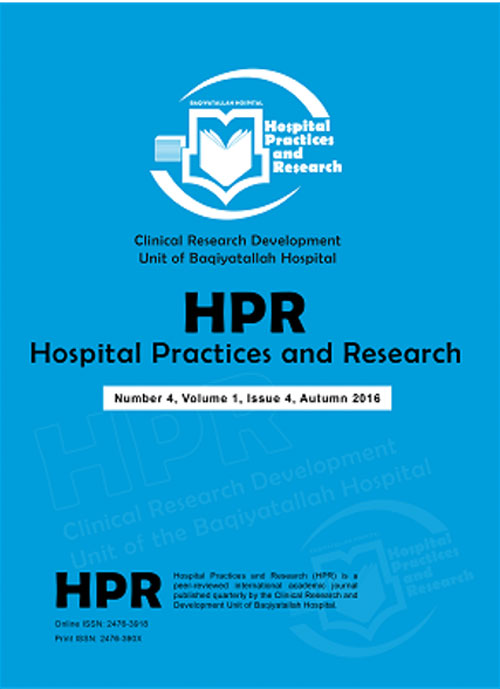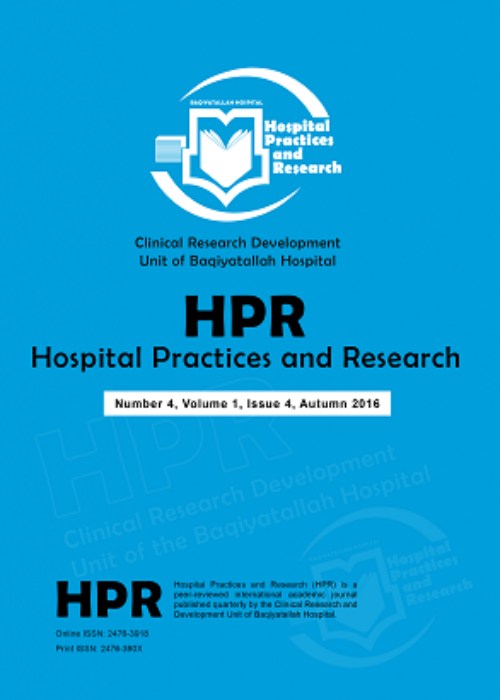فهرست مطالب

Hospital Practices and Research
Volume:7 Issue: 1, Winter 2022
- تاریخ انتشار: 1401/03/11
- تعداد عناوین: 8
-
-
Pages 1-3
Osteoarthritis (OA) is the most common form of arthritis, causing pain and progressive disability in millions of people worldwide. The commonly prescribed medications for OA, including non-steroidal anti-inflammatory drugs, have many side effects which has led the scientists to consider safer drugs as an alternative. Therapeutic effects of Curcumin on OA are increasingly declared, and its various aspects in suppressing inflammation and reducing the disease progression are examined more thoroughly. This study aims to discuss curcumin and OA to help scientists working in these fields. In this brief review, we took a look at OA pathogenesis, the role of the immune system, and the biomarkers involved in the onset and progression of the disease. We focused on available data on the anti-inflammatory effect and mechanism of treatment by curcumin on OA.
Keywords: curcumin, osteoarthritis, Inflammation, Biomarkers -
Pages 4-10Background
The coronavirus disease 2019 (COVID-19) pandemic resulted in the diversion of all the resources, attention, and energy of the medical personnel and administration towards the management of COVID-19 patients. This resulted in unforeseen difficulties and hazards for non-COVID-19 patients in accessing healthcare professionals and facilities.
ObjectivesThe objective of this study was to analyze the impact of the COVID-19 pandemic and repeated lockdowns on the non-COVID patients; to understand the social, psychological, and medical issues faced by them; and propose solutions for difficulties faced by this specific cohort of patients.
MethodsWe conducted a retrospective observational study on all non-COVID patients reporting for non-COVID-19 illnesses. We conducted the data analysis by comparing the trends for 15 months each in the pre-pandemic (1 January 2019 to 31 March 2020) and pandemic periods (1 April 2020 to 30 June 2021).
ResultsThere was a 65.92% decrease in Out Patient Department (OPD) attendance, a 56.05% decrease in admissions, and a 90.33 % decrease in elective surgical procedures in non-COVID-19 patients. However, there was a significant increase in emergency surgeries by 62.16%.
ConclusionThere has been a significant albeit much-needed diversion of time, energy, and resources to manage COVID-19 patients in recent times. This has led to a paucity of care opportunities for non-COVID-19 patients, which has been further compounded by the frequent lockdowns. We attempted to understand the impact of the pandemic on non-COVID-19 patients, particularly in peripheral hospitals in Hilly Terrains. We propose the solutions to tackle these issues and describe our experience with them.
Keywords: COVID-19 pandemic, environmental exposure, Primary Healthcare, Hospital Administration -
Pages 11-16BackgroundThe world is still witnessing a largely ongoing spread of coronavirus disease 2019 (COVID-19); therefore, the scientific findings in this area need to be shared promptly.ObjectivesThis study aimed to assess the usefulness of Atorvastatin treatment in reducing COVID-19 mortality in patients with or without diabetes mellitus (DM) and to correlate them with C-reactive protein (CRP) levels.MethodsThis study consecutively enrolled patients with pneumonia symptoms, positive lung CT scan, and confirmed severe acute respiratory syndrome coronavirus 2 (SARS-CoV-2) on reverse transcription-polymerase chain reaction (RT-PCR). The outcome was defined as intensive care unit (ICU) admission and death. Clinical data and history of atorvastatin administration were evaluated. CRP levels were measured at baseline and repeated after one week in all patients.ResultsA total of 200 patients were included. Their mean age was 60.5 (SD = 16.5) years, 113 (56.5%) patients were male, 47 (23.5%) with pre-existing diabetes, and 64 (32%) patients were taking atorvastatin routinely. 68 (34%) required ICU admission of all the studied patients. No gender differences were found in ICU admission and death. The baseline CRP was not significantly different, but the secondary CRP was significantly different between DM and non-DM groups. Secondary CRP also showed a significant reduction in patients receiving atorvastatin (P = 0.017). The mortality was the same in atorvastatin or non-atorvastatin groups (P = 0.715).ConclusionIt seems that taking statin has only some beneficial effects on improving CRP levels in patients with COVID-19. To achieve a reliable result, clinical trials are recommended.Keywords: Statins, COVID-19, mortality, C-reactive protein, Diabetes Mellitus
-
Pages 17-22BackgroundEfficient hospital bed utilization is an important function of hospital administrators. Scarcity of beds, overcrowding, and flooring are often the picture of tertiary hospitals.ObjectivesThis study aims to find out hospital bed utilization indicators such as average daily census, bed occupancy rate (BOR), average length of stay (ALS), bed turnover rate (BTR), and bed turnover interval (BTI) in Medicine ward of a tertiary hospital in West Bengal, India.MethodsA descriptive cross-sectional study was conducted in acute male and female as well as chronic male and female wards under medicine department of a tertiary hospital in West Bengal from June to August 2018.The record of active beds, patient days, daily admissions and discharge were reviewed for May 2018 by complete enumeration method from admission, discharge and death registers and recorded in a pre-designed pretested checklist. Average daily census, BOR, ALS, BTR, and BTI were computed using standard formula. Pabon Lasso model was used to analyse the performance of the nedicine ward.ResultsAverage daily census, ALS, BOR, BTR, BTI in medicine ward were 261.81 patients, 8 days, 108.55%, 4.22 patients/ bed and -0.63 days respectively. Pabon Lasso graph reflected high BOR and high discharges per bed (productivity) in acute medicine wards reflecting good quantitative performance in contrast to chronic medicine wards with low discharges per bed (productivity or BTR) and higher ALS.ConclusionMedicine ward reflected higher BOR and ALS but lower BTR (productivity) as per the Pabon Lasso graph. Efforts must be made to reduce ALS in chronic medicine wards.Keywords: bed occupancy, Facilities, Services utilization, Hospital Administration, Hospital bed, Utilization
-
Pages 23-27BackgroundVarious studies indicate that in many cases, fire has broken out in hospitals.ObjectivesThis study aims to assess fire protection in the selected units of Imam Khomeini hospital located in Tehran, Iran in 2020.MethodsIn this descriptive-analytic study, first, a researcher-made checklist was developed for the data collection by valid scientific resources (CVI = 0.90 and CVR > 0.62). After revising and the final confirmation of reliability, the checklist was separately completed by two members of the risk management committee in 22 units of Imam Khomeini Hospital, Tehran, Iran. Cronbach’s weighted Kappa statistical test was calculated.ResultsThe domain of Ability and Capability of Fire Prevention was 66.1%; the domain of Responsiveness was 65.1%, and the domain of Urgent Evacuation Ability was 27.3%. In the domain of Responsiveness, the highest scores were relevant to accessing fire extinguishers cylinder in the units (95.5%) and holding fire extinguishing practice courses, and doing seasonal practices with that region’s fire station (90.9% for both). The highest scores in the domain of Urgent Evacuation Ability were assigned to accessing adequate ambulances to evacuate patients (90.9%) and mapping the units as well as determining patient evacuation routes when a fire breaks out (72.7%).ConclusionThe essential protection measures should be taken in order to improve the hospitals’ fire protection by better access to the exits, increasing the number of the exits and standardizing the emergency exits, enhancing the due fire extinguishing practices and hospital evacuation as well as training the staff.Keywords: safety, Fire, Hospitals
-
Pages 28-32BackgroundCanceling surgery imposes the high cost of the healthcare provider system and wasted many energy and time from the patient and the care team.ObjectivesThis study examined the extent and reasons of canceling of surgeries in one of the hospitals affiliated to Shahid Sadoughi University of Medical Sciences, Yazd, Iran.MethodsThis was a descriptive-applied study. In order to get the number of operations from April 2018 to March 2020, the hospital used HIS software and then extracted the reasons from the operating room office and the quality improvement office in the hospital. Data were analyzed by SPSS version 21 software.ResultsAmong 8654 planned surgeries, 0.9% were cancelled. The highest frequency of surgical cancellation is associated with general surgery, and the highest rate of surgical cancellation is associated with the ENT specialty. The highest cancellation rate was 1.82% in August 2018 and 2.87% in February 2019. The lack of preparation of patients and patients did not require surgery was the main and worst reason for discontinuing surgery, respectively.ConclusionThe lack of clinical preparation of the patient was the main reason for the cancellation. Therefore, pre-surgery patient evaluation can help solve this problem, make the operating room more effective, and increase patient satisfaction.Keywords: Surgery, Operating room, Hospital, cancellation of surgery
-
Pages 33-36Introduction
During the current worldwide pandemic of coronavirus disease 2019 (CPVID-19), this disease was first identified in Iran at the end of February. This study was conducted to examine patients with severe COVID-19 disease, who were treated with three medications, namely ReciGen, methylprednisolone, and Sovodak.
Case PresentationWe identified 10 patients (3 males and 7 females) with the mean (± SD) age of 55.70 ± 21.48 years, who were admitted to the only referral hospital in Rafsanjan County (Iran) from March to July 2020 with confirmed infections with severe COVID-19. They were treated with the combination therapy of subcutaneous ReciGen interferon every other day, methylprednisolone at a dose of 250 mg every 6 hours for 5 days, and one tablet of Sovodak daily.
ConclusionIn the series of cases investigated in this study, the general conditions of all patients improved in terms of their clinical parameters after receiving the combination therapy, and all patients were discharged with a blood oxygen level of ≥ 93% and in good general conditions.
Keywords: COVID-19, Interferon-beta, Methylprednisolone, therapy -
Transfusion-Related Hemochromatosis Involving Pituitary Gland in a Patient of Beta-Thalassemia MajorPages 37-40Introduction
Hemochromatosis of the pituitary gland is a form of iron overload disease which occurs in different clinical conditions related to multiple blood transfusions.
Case PresentationWe present a case of secondary hemochromatosis involving the pituitary gland and choroid plexus in an eight-year-old female with imaging findings and a review of the relevant literature. Our patient has had a history of cessation of growth in height for the last 1 year. She was diagnosed with a thalassemia major at the age of 6 months. She has been on regular blood transfusions since then. Magnetic resonance imaging (MRI) revealed evidence of iron deposition in the pituitary gland.
ConclusionThis diagnosis should be suspected on clinical presentation and history of multiple blood transfusions. It can be confirmed based on characteristic imaging findings. The patient should be strictly monitored with serum iron levels, and a tailored iron chelation therapy should be initiated.
Keywords: Hemochromatosis, Blood transfusion, Thalassemia, Chelation Therapy, MRI scans


